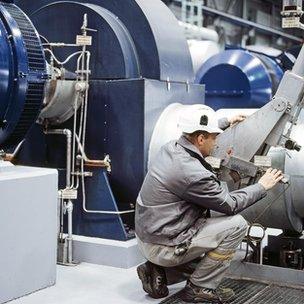Are Denmark's renewable energy goals wishful thinking?
- Published

Huge investment will be needed if the Danish government's goals are to be met
The politician wanted to make one thing absolutely clear. "We are not," she said, "just hippies."
Perhaps it sounded a little over-defensive, but then what Lykke Friis was defending was a remarkably bold initiative.
Denmark has announced that by the end of this decade, it will produce a third of its energy from renewable sources - wind power, in particular, but also solar power and the burning of "biomass."
More ambitiously, the Danish Government has set a goal of running the entire country on renewables by 2050.
What makes Denmark's announcement even more unusual is that it has won support from across the country's political spectrum.
Ms Friis, for example, is a front-bench spokeswoman for the opposition Liberal Party, right-of-centre and fiercely pro-business. For her, the decision to ditch fossil fuels is a matter of sound financial planning.
"No matter what we do, we will have an increase in the price of energy, simply because people in India and China want to have a car, want to travel," she says.
"That is why we came out with a clear ambition to be independent of fossil fuels: so we are not vulnerable to great fluctuations in energy price."
There is an historical experience at work here. The oil-shocks of the early nineteen-seventies were a particular blow to Denmark.
With few home-grown sources of energy, the country saw prices rocket, and this led to widespread acceptance that a new path needed to be taken.
Nuclear power was never seriously considered, the opposition from politicians and civil society always strong. So long before other countries, Denmark began developing renewables, and is now something of a world leader, particularly in the field of wind power.
Storage problem
At the Avedore Power Plant, just outside Copenhagen, nearly a thousand megawatts of energy is being generated from renewables, enough to sustain a quarter of a million homes.

The Avedore power plant generates enough energy from renewables to sustain roughly 250,000 homes
Some of this is from giant wind turbines, but most comes from two biomass plants, burning straw and other types of industrial waste.
The plant is run by Denmark's largest power company, Dong Energy, and they too have ambitions to take this process further, to the point where almost all their electricity will come from clean sources.
"It's a huge transformation of the company," says executive vice-president Thomas Dalsgaard. "We believe the future is not based on coal. But it is difficult; you have to make a whole new way of operating the business."
And it is not only individual power stations that have to be modified, nor is it a matter simply of building more wind-turbines and other power plants. For a start, there is the challenge of storing all the energy produced by renewables, for use when the sun is not shining and the wind is still.
Engineers are looking at proposals to generate heat from electricity when it is available, and then using it later. They also hope to expand the number of electric cars in Denmark; they could act effectively as rechargeable batteries. But all these are very much in the development stage.
Another challenge is distribution. Conventional power stations are located close to towns and cities. If wind farms are built far out at sea as planned, then a wide network of cables will have to be built, to bring that power to land, and on to the places where consumers use it.
"Huge investments are going to be needed," says Erik Kristofferson, from Energinet, which runs Denmark's grid system, "And these investments are needed now. It's a political choice, but we believe it can be done."
Bjorn Lomborg is not convinced. Perhaps the world's most famous critic of renewable energy, Lomborg despairs that his own country has committed to a future based on wind, wave and solar power.
"Putting up windmills makes us feel good," Lomborg argues, "But this will reduce economic growth….Green energy is much more expensive than fossil fuels. We should fix climate change by moving from very-polluting coal, to much less polluting gas."
Lomborg draws particular attention to the potential of "shale gas" stored underground, which has been hailed as a new and bountiful source of energy.
Unknown quantities
But the actual quantities of shale gas remain unknown. Poland was boasting until recently that shale could supply much if not most of its energy needs; it has now had to downgrade its estimates of the amount available.
And shale gas needs to be extracted by a process known as "fracking", which some argue causes severe environmental damage.
For Denmark's Energy Minister, Martin Lidegaard, shale does not provide solutions, any more than other fossil fuels. Its price, he warns, could be just as volatile.
"The risk that we will see explosions in resource prices is there. What we want is to secure a stable, clean and cheap energy supply." he says.
The Minister acknowledges that they cannot calculate the price of a complete transition to renewables, but argues that it still makes financial sense, and not just for Denmark.
He says: "I am 100% sure not only that other countries could to it, but that they will do it, simply because of the development of the markets. Each will have to find their own solutions, but will it happen? Yes."
Denmark's new commitment to renewables does still have to be debated by the country's Parliament. But with almost every MP supporting the move, approval should be a formality.
After that though, the real work begins: working out exactly how to turn this ambitious goal into a physical reality.
Listen to Paul Moss's report on the World Tonight, at 22:00 on Monday on BBC Radio 4..
- Published5 April 2012
- Published29 March 2012
- Published15 March 2012
- Published1 December 2011